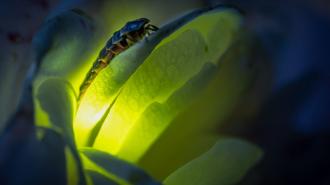In a scientific first, researchers have used machine learning-powered AI to design de novo enzymes — never-before-existing proteins that accelerate biochemical reactions in living organisms. Enzymes drive a wide range of critical processes, from digestion to building muscle to breathing.
A team led by the University of Washington’s Institute for Protein Design, along with colleagues at UCLA and China’s Xi’an Jiaotong University, used their AI engine to create new enzymes of a kind called luciferases. Luciferases — as their name implies — catalyze chemical reactions that emit light; they’re what give fireflies their flare.
In a scientific first, researchers have used machine learning-powered AI to design never-before-existing enzymes.
“Living organisms are remarkable chemists,” David Baker, a professor of biochemistry at UW and the study’s senior author, said.
“Rather than relying on toxic compounds or extreme heat, they use gentle enzymes to break down or build up whatever they need. If we could create new enzymes, that would put renewable chemicals and biofuels within reach.”
Deep learning design: There’s been a recent glut of headlines about AI-powered creations — especially text generators, like ChatGPT, or image generators, like the wonderfully named DALL-E.
But similar AI has also found a place in discovering new drugs, proteins, and antibodies.
A Boston-based startup has created an AI model that utilizes the same technique that DALL-E uses to create images to design brand new artificial proteins. And by feeding the “language of biology” to a ChatGPT-like AI, California biotech Profluent has created new proteins capable of killing bacteria.
High-powered AI is a key component of protein design because they are wildly complex molecules, honed by eons of evolution. The number of possible intricate and important structures that can make all the difference to what a protein does is difficult to comprehend. (We’re talking a google cubed, here.)
Enzymes accelerate biochemical reactions, and drive a wide range of critical processes from digestion to building muscle to breathing.
A new catalyst: In a study published in Nature, the team, led by UW postdocs Andy Hsien-Wei Yeh — who is also the co-founder of light-emitting diagnostic biosensor maker Monod Bio — and Christoffer Norn, began by choosing the chemicals they wanted their luciferases to catalyze in light-emitting reactions (these are called luciferins, building on a theme).
They then tasked the AI with creating thousands of possible proteins that could interact with the luciferins. Those first models looked potentially disappointing in the lab, barely causing a chemical reaction at all.
But through continued refinement, the team was able to improve the performance of their luciferases; the most successful, LuxSit-i, produced a bright enough glow to be visible to the naked eye, outperforming natural luciferases found in the glowing sea pansy (a kind of bioluminescent soft coral).
The bioluminescence created by luciferases is extremely useful for testing chemicals in the lab and for biomedical imaging, the team wrote in their paper. Because they don’t need an outside light source, the glow of luciferases can be produced in the dark, providing higher sensitivity than some fluorescent markers in living samples.
But the difficulty of developing luciferases, and the limited number of known naturally occurring enzymes, meant that research into them has lagged behind more well-established fluorescent work.
“If we could create new enzymes, that would put renewable chemicals and biofuels within reach.”
david baker
The bigger deal: The team sees their work as potentially bigger than creating some new glowing enzymes, however.
With the AI method proven, the door is now open to creating a wide array of enzymes capable of a wide array of biochemical reactions. Artificial enzymes could create improved biofuels, serve as medical diagnostic tools, or break down pollutants.
“We were able to design very efficient enzymes from scratch on the computer, as opposed to relying on enzymes found in nature,” Yeh said. “This breakthrough means that custom enzymes for almost any chemical reaction could, in principle, be designed.”
We’d love to hear from you! If you have a comment about this article or if you have a tip for a future Freethink story, please email us at tips@freethink.com.
